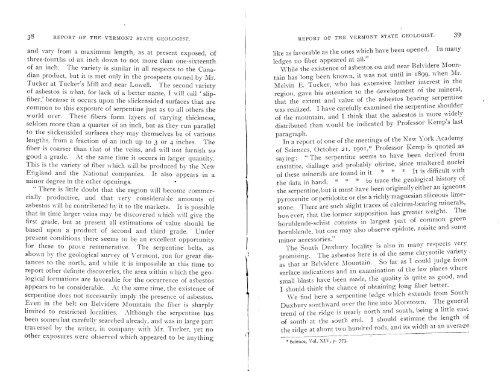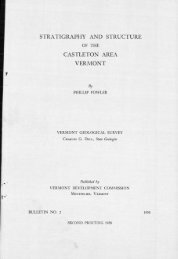Mineral Industries and Geology of Certain Areas - Vermont Agency ...
Mineral Industries and Geology of Certain Areas - Vermont Agency ...
Mineral Industries and Geology of Certain Areas - Vermont Agency ...
You also want an ePaper? Increase the reach of your titles
YUMPU automatically turns print PDFs into web optimized ePapers that Google loves.
38 REPORT OF THE VERMONT STATE GEOLOGIST.<br />
<strong>and</strong> vary from a maximum length, as at present exposed, <strong>of</strong><br />
three-fourths <strong>of</strong> an inch down to not more than one-sixteenth.<br />
<strong>of</strong> an inch. The variety is similar in all respects to the Canadian<br />
product, but it is met only in the prospects owned by Mr.<br />
Tucker at Tucker's Mill <strong>and</strong> near Lowell. The second variety<br />
<strong>of</strong> asbestos is what, for lack <strong>of</strong> a better name, I will call ' slipfiber,'<br />
because it occurs upon the slickensided surfaces that are<br />
common to this exposure <strong>of</strong> serpentine just as to all others the<br />
world over. These fibers form layers <strong>of</strong> varying thickness,<br />
seldom more than a quarter <strong>of</strong> an inch, but as they run parallel<br />
to the slickensided surfaces they may themselves be <strong>of</strong> various<br />
lengths, from a fraction <strong>of</strong> an inch tip to 3 or 4 inches. The<br />
fiber is coarser than that <strong>of</strong> the veins, <strong>and</strong> will not furnish sc<br />
good a grade. At the same time it occurs in larger quantity.<br />
This is the variety <strong>of</strong> fiber which will be produced by the New<br />
Engl<strong>and</strong> <strong>and</strong> the National companies. It also appears in a<br />
minor degree in the other openings.<br />
There is little doubt that the region will become commerciallv<br />
productive, <strong>and</strong> that very considerable amounts <strong>of</strong><br />
asbestos will he contributed by it to the markets. It is possible<br />
that in time larger veins may be discovered which will give the<br />
first grade, but at present all estimations <strong>of</strong> value should be<br />
based upon a product <strong>of</strong> second <strong>and</strong> third grade. Under<br />
present conditions there seems to be an excellent opportunity<br />
for these to prove remunerative. The serpentine belts, as<br />
shown by the geological survey <strong>of</strong> <strong>Vermont</strong>, run for great distances<br />
to the north, <strong>and</strong> while it is impossible at this time to<br />
report other definite discoveries, the area within which the geological<br />
formations are favorable for the occurrence <strong>of</strong> asbestos<br />
appears to be considerable. At the same time, the existence <strong>of</strong><br />
serpentine does not necessarily imply the presence <strong>of</strong> asbestos.<br />
Even in the belt on Belvidere Mountain the fiber is sharply<br />
limited to restricted localities. Although the serpentine has<br />
been somewhat carefully searched already, <strong>and</strong> was in large part<br />
traversed by the writer, in company with Mr. Tucker, vet no<br />
other exposures were observed which appeared to be anything<br />
ME<br />
REPORT OF THE VERMONT STATE GEOLOGIsT. 39<br />
like as favorable as the ones which have been opened. In many<br />
ledges no fiber appeared at all."<br />
While the existence <strong>of</strong> asbestos on <strong>and</strong> near Belvidere Mountain<br />
has long been known, it was not until in 1899, when Mr.<br />
Melvin E. Tucker, who has extensive lumber interest in the<br />
region, gave his attention to the development <strong>of</strong> the mineral,<br />
that the extent <strong>and</strong> value <strong>of</strong> the asbestos bearing serpentine<br />
was realized. I have carefully examined the serpentine shoulder<br />
<strong>of</strong> the mountain, <strong>and</strong> I think that the asbestos is more widely<br />
distributed than would be indicated by Pr<strong>of</strong>essor Kemp's last<br />
paragraph.<br />
In a report <strong>of</strong> one <strong>of</strong> the meetings <strong>of</strong> the New York Academy<br />
21, 1901,*<br />
<strong>of</strong> Sciences, October<br />
Pr<strong>of</strong>essor Kemp is quoted as<br />
saying: " The serpentine seems to have been derived from<br />
enstatite, cliallage <strong>and</strong> probably olivine, since unaltered nuclei<br />
<strong>of</strong> these minerals are found in it. * * * It is difficult with<br />
the data in h<strong>and</strong>, * * to trace the geological history <strong>of</strong><br />
the serpentine, but it must have been originally either an igneous<br />
pyroxenite or peridotite or else a richly magnesian siliceous limestone.<br />
There are such slight traces <strong>of</strong><br />
ca l cium_bearing minerals,<br />
however, that the former supposition has greater weight. The<br />
hornblende-Schist consists in largest part <strong>of</strong> commOil green<br />
hornblende, but one may also observe epidote, zoisite <strong>and</strong> some<br />
minor accessories."<br />
The South Duxhury locality is also in many respects very<br />
promising. The asbestos here is <strong>of</strong> the same chrysotile variety<br />
as that at Belvidere Mountain. So far as I could judge from<br />
surface indications <strong>and</strong> an examination <strong>of</strong> the few places where<br />
small blasts have been made, the quality is quite as good, <strong>and</strong><br />
I should think the chance <strong>of</strong> obtaining long fiber better.<br />
We find here a serpentine ledge which extends from South<br />
Duxbury southward over the line into Moretown. The general<br />
trend <strong>of</strong> the ridge is nearly north <strong>and</strong> south, being a little east<br />
<strong>of</strong> south at the south end. I should estimate the length <strong>of</strong><br />
the ridge at about two hundred rodis, <strong>and</strong> its width at an averae<br />
Science, vol. XIV, p. 773.













